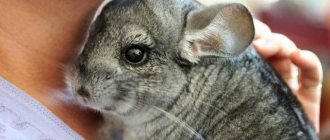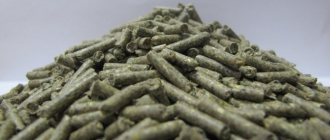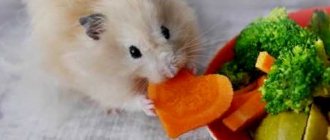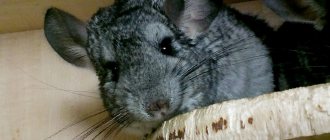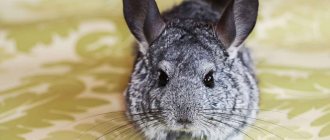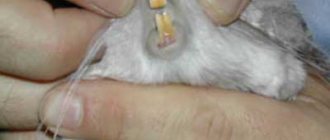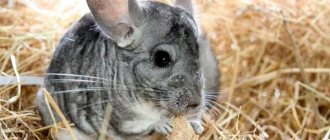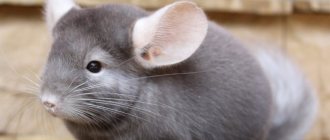How difficult is it to keep chinchillas at home?
The animal will happily live in the cage if it is large enough. Chinchillas are very active. They run a lot and jump often. A house for a mobile rodent measuring 110x90x50 will be just right.
During daylight hours, chinchillas love to sleep. And by nightfall they begin to show interest in food, owners, and the environment. The favorite pastime of these animals is to stir things up. For this reason, various rustling noises are often heard in the house. But lovers of cute rodents quickly get used to such a background and stop reacting to it.
Walk
The animal must be allowed to walk around the room. But you can’t leave it unattended for even a minute. Chinchilla is a representative of the rodent order. Everything that comes into their field of vision must be tasted. They especially love to feast on wires. Therefore, you need to closely monitor the animal while walking. For those who do not want to reap the benefits of their festivities, they can purchase a special ball for walking. The animal is placed inside a transparent plastic ball and, moving its paws, travels throughout the house. This will keep cords, furniture and everything in the house safe. Such transport for an animal is inexpensive. You can buy him bright toys, a wheel, ladders so that he doesn’t get bored while you’re not at home.
What to feed the animals
Proper care of a chinchilla at home involves proper and balanced nutrition. This type of rodent belongs to the family of herbivores. Specialized food is used when living at home. A chinchilla's house should always have hay and fresh water. Animals are always not averse to eating. To get a “yummy” - a nut, a seed or a raisin, they can depict touching scenes. But you have to be careful with this. This kind of food is not for chinchillas. A delicacy that is beneficial for their health and appearance is a slice of dried apple, a piece of carrot, or hawthorn.
Molars in rodents will continue to grow throughout their lives. To wear them down, buy your pet a salt mineral stone. By the way, the chinchilla receives beneficial substances from the stone. In the spring-summer season, you can give the rodent dried branches of apple and birch trees.
Vitamins
Contrary to popular belief, there is no need for additional vitamins. If a chinchilla's diet is complete and varied, it contains a lot of succulent food, as well as high-quality granulated food, then the animal is unlikely to have a deficiency of any vitamin.
The list of things you can feed a chinchilla is quite large and creating a full menu for your pet will not be difficult. Another important point is that all vitamins are of chemical origin and still belong to medicines. Therefore, it is better not to add them to food unless necessary. The exceptions are animals that are preparing for an exhibition, pregnant and lactating females, as well as those recovering from illness.
What is the best microclimate to organize for rodents in an apartment?
It is very important to have air conditioning in your home if you live in hot climates. High temperatures have a detrimental effect on chinchillas. In this regard, caring for a chinchilla at home presents some difficulties. The best temperature parameter for animals is +17, +22° Celsius. The minimum temperature should not fall below 14°, and the maximum should not rise above 28°. But this high should not last long. At a room temperature of about 29-30°, the chinchilla quickly dies due to heat stroke.
Prolonged exposure to sunlight has a negative effect on the health of rodents. Sunbathing can be done for pets for 10-15 minutes during the daytime. In case of heat stroke, the animal should be cooled using a container of frozen or very cool water. Chinchillas also do not like drafts. So it is better to install the cage in places that are safe in this regard.
Chinchillas do not tolerate loud noise well, so home care also includes limiting the strength of the background sound. Animals are easily frightened by sharp, loud sounds, but they can get used to TV shows and keep you company while watching. But ideally, the best conditions are peace and quiet.
Recovery after illness
If a chinchilla does not eat or drink for several days, this leads to inevitable weight loss. During the period of recovery from illness, proper and balanced feeding is very important to avoid exhaustion and death of your furry pet. If a chinchilla has not drunk anything for a long time and refuses water, it must be artificially watered from a syringe without a needle. During one drinking session, up to seven milliliters of liquid are injected into the animal’s mouth. It is good to feed the animal dairy-free oatmeal, to which you can add a little calcium. Porridge is fed twice a day - morning and evening.
If the chinchilla refuses to eat on its own, you can inject a little porridge through a syringe into the animal’s cheek.
After using medications, the liver inevitably suffers. To restore normal liver function, you can use the drug Karsil. The course lasts one month. The animal is given three times a day, one-fourth of the tablet dissolved in water. It is also good to take a course of vitamin Gamovit injections. For chinchillas, subcutaneous administration of 0.5 ml of the drug once a day is enough. Minimum - five days. If appetite and activity are completely restored, you can stop injections. Gamovit can be replaced or used together with Catozal, which improves the metabolic process in the body. Catozal is also placed subcutaneously in the withers area, once a day for five days.
It is recommended to use Lactobacterin or Bifidium as probiotics. Half the ampoule is mixed with ten milliliters of water and soldered through a syringe at a time. The probiotic helps well in normalizing intestinal function and eliminates all the negative consequences of antibiotic use. You can also use the probiotic Vetom 1.1. Dosage - dissolve a gram or two of the drug in two teaspoons of water and drink it through a syringe twice a day.
What do pets get sick of?
Most often, in captivity, chinchillas suffer from dental problems (overgrown hooks) and disorders of the gastrointestinal tract (inflammatory processes in the intestines, diarrhea, food obstruction).
But even an inexperienced person can recognize such diseases. And if the owner takes the necessary measures in time, the rodent’s health will quickly recover.
No vaccinations are provided for rodents living in human homes. They still receive preventive vaccination against dermatitis in the nursery. Proper care and feeding is the key to a painless existence for your pet.
Chinchilla and its maintenance at home: let's start with studying the appearance
In nature, there are generally only two varieties of this rodent - the small long-tailed chinchilla and the large short-tailed chinchilla, the content of which is no different. They all have a natural gray color called agouti - darker on the back, lighter on the belly and paws. But in captivity, breeders have bred more than 40 different breeds of chinchillas, distinguished by a variety of colors. Now you can buy a chinchilla not just white, but velvety white. But that's not all - there are animals of beige with a pink tint, sapphire or purple color.
Species and habitat
- Chinchillas are cute, charming animals that are easily tamed, tolerate captivity well and have a lifespan of 12-15, and sometimes up to 20 years. Their weight is 500-800 g, while females are always larger than boys
- Body length - 25-38 cm
- Tail length – 8-17 cm; The short-tailed species has very massive hind legs and neck
Review
Where to buy a chinchilla
It is highly not recommended to purchase animals at markets. Firstly, by doing this you support the illegal import of rodents. Secondly, market traders and transporters do not care at all about the standards for keeping animals, which is why they often get sick and quickly die.
To purchase a known healthy animal, look for experienced breeders or officially operating nurseries. In this case, the owner will tell you about the pet’s age and its taste preferences. The fact is that chinchillas have a “weak” stomach. And a sudden change in food causes them diarrhea (the animals curl up their ears and lose activity). It is necessary to transfer the rodent to another food in stages.
For what reasons does a chinchilla not drink water from a drinking bowl?
Any changes in living conditions and environment cause a stress reaction in the animal. A new partner, a change of cage or place, or a noisy environment can cause a rodent to refuse food and drink. Some expert recommendations for such situations:
- When it is definitely established that the animal has not used the drinking bowl for more than a day, you can try giving water in another container - a spoon, bowl, or the owner’s palm.
- If the rodent still refuses, it is advised to give it something to drink from a syringe. You just have to remember that this is a lot of stress for the animal. You can resort to this method only as a last resort, for example, if your pet is constipated.
- A dried apple that you can offer to your chinchilla will give the body some moisture. Having calmed down, she will return to the drinking bowl.
- If the animal has previously been given water from a saucer or bowl, you should simply accustom it to the new device. Usually it is enough to show how the device works, and the chinchilla begins to use it.
If the animal behaves as usual, is active, eats well and sleeps, it means that the owner simply does not notice when his pet drinks or the rodent gets enough moisture from the food it eats. In any case, there is no reason to worry.
Article on the topic: How to make a maze for a hamster with your own hands: building tunnels, pipes and obstacle courses
Flaws
Despite the numerous advantages, there are some disadvantages to keeping chinchillas. The main disadvantages of fluffies include:
- Nocturnal lifestyle . Chinchillas sleep almost all day and wake up only in the evening. Their peak activity occurs between sunset and sunrise. Moreover, while awake, fluffies behave quite noisily. Naturally, people with sensitive sleep will find it difficult to get along with nocturnal pets.
- Long period of domestication . Chinchillas are relatively wild animals that do not go to the hands of the first person they meet. After moving to a new place of residence, the pet will need a long adaptation. The process of getting used to the owner takes about a month. And taming will take 2-3 times longer.
- Lack of specialized veterinarians . Chinchillas rarely get sick. However, if trouble does happen, it is quite difficult to find a veterinarian who specializes in chinchillas, or at least in rodents in general. As a result, the pet receives poor quality medical care. This problem is especially acute in the provinces.
- High price . At the poultry market, you may be able to buy an animal for 400-500 rubles. However, in a professional nursery, where the breeder is fully responsible for the health and psychological state of his charges, prices for chinchillas jump to 2-3 thousand rubles.
- Low contact . You won’t be able to pick up a chinchilla against its will or play like you would with a kitten at any convenient time. These rodents have a complex character. They make contact with the owner only after complete grinding in, and only when they themselves want it.
- Sensitive digestive system . According to statistics, in 90% of cases, pet chinchillas die due to poor nutrition. The digestive organs of chinchillas are designed taking into account the fact that the animal will feed on coarse fibrous food. However, some owners, in addition to specialized food and some approved products, give their pets various “goodies” - sweets, chips, salted seeds and nuts. As a result, animals simply die due to the development of pathologies of the gastrointestinal tract. Even the slightest deviation from the diet is fraught with serious consequences.
- The possibility of an attack is small, but it is there. Chinchillas have a complex character; they are very obstinate, timid and, moreover, vindictive. If the owner does not please the pet in some way, he may get bitten. Fortunately, fluffies bite does not hurt at all. In addition, when kept in groups, fights may occur in the cage. This mainly occurs during sexual activity.
As you can see, keeping chinchillas has many more advantages than disadvantages. If you sincerely want to have a furry, the listed features are quite surmountable.

